Powerlifting and powerbuilding are both extremely popular styles of training. It’s hard to deny the visceral joy of getting stronger, and building muscle can be just as satisfying. Powerlifting is both a strength sport and the pursuit of maximal strength across a few key exercises.
On the other hand, powerbuilding involves pursuing both strength and muscle simultaneously. Powerbuilders aim to get strong and shredded in the gym. However, all is not sunshine and rainbows – there is a drawback to splitting your focus.
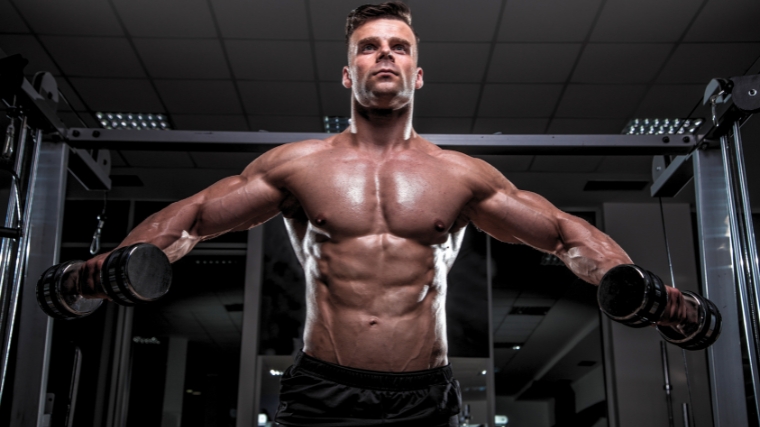
While there are some stark differences between powerlifting and powerbuilding, there are also some significant areas of overlap that may make your final decision a bit challenging. To make the most informed decision that you can, here is everything you need to know about powerlifting vs. powerbuilding.
- What Is Powerlifting?
- What Is Powerbuilding?
- Powerlifting vs. Powerbuilding Training
- Powerlifting vs. Powerbuilding Nutrition
- Powerlifting vs. Powerbuilding Competition
- Can You Do Both?
What Is Powerlifting?
Powerlifting is a sport that culminates in a competition that tests the maximal strength of your squat, bench press, and deadlift. Even without the competitive component, recreational powerlifters take their craft just as seriously.
As a powerlifter, your training routines and recovery tactics will all be tailored toward producing increases in your 1-repetition maximum (1RM) of the “Big 3” lifts. However, recreational powerlifters also train for the broader goal of increasing their full-body strength.
What Is Powerbuilding?
Powerbuilding blends two styles of training — powerlifting and bodybuilding. Although powerlifting and bodybuilding are formalized sports with separate parameters and competitions, powerbuilding itself is loosely-defined and comparatively forgiving. It’s not a recognized sport, but a training philosophy. Powerbuilding workouts usually prioritize a major barbell movement pattern (squats, hinges, presses) before diving into more muscle-group-specific training for hypertrophy.
This is mostly similar to how bodybuilders train, however some bodybuilders opt out of heavy barbell-based exercises in favor of more isolation moves. Powerbuilding balances these two paths, keeping strength at the forefront while still accounting for muscle gain.
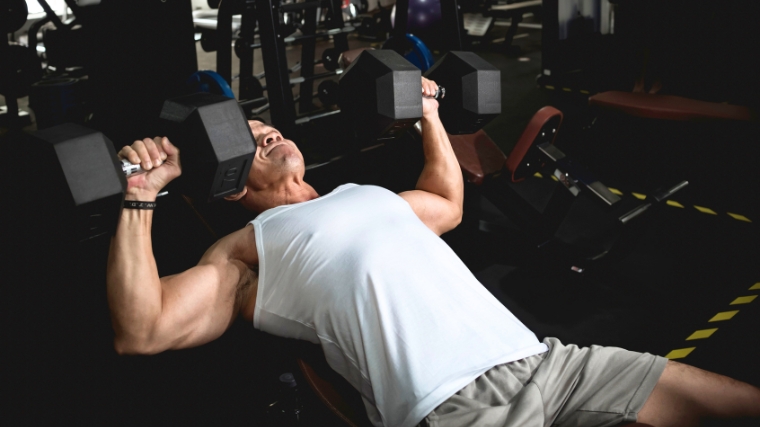
[Read More: Nutrition for Athletes — How to Eat for Muscle and Performance]
In the long haul, powerbuilding can get you super strong, super jacked, but also serve as a launching point for a more focused foray into powerlifting or bodybuilding in the future. The main drawback here is that powerbuilding requires you to split your efforts: pursuing strength and muscle simultaneously and equally will slow your rate of progress compared to focusing on one at a time.
Powerlifting vs. Powerbuilding Training
Specificity (or how similar your training sessions look to your competition or goal) is one of the defining traits of powerlifting. In powerbuilding, this layer of strictness is a bit thinner; in order to get stronger you certainly need to train heavy, but your exercise options are more broad.
Programming Styles
Powerlifting specifically focuses on movement patterns. Any exercise that you perform should be in service of improving your bench press, back squat, or deadlift in some way. Powerlifters certainly utilize isolation exercises during their accessory work, but you’ll approach those moves through the lens of improving your maximal competitive lifts.
Powerbuilders aren’t bound to three specific exercises, which opens up possibilities in workout design. As a powerbuilder, you’re free to opt for variations of the press, squat, or hinge that may be more comfortable for you. While you’ll still pursue strength in those exercises, you’ll follow them up with more time spent on building a well-rounded physique via equipment like machines, cables, or free weights.
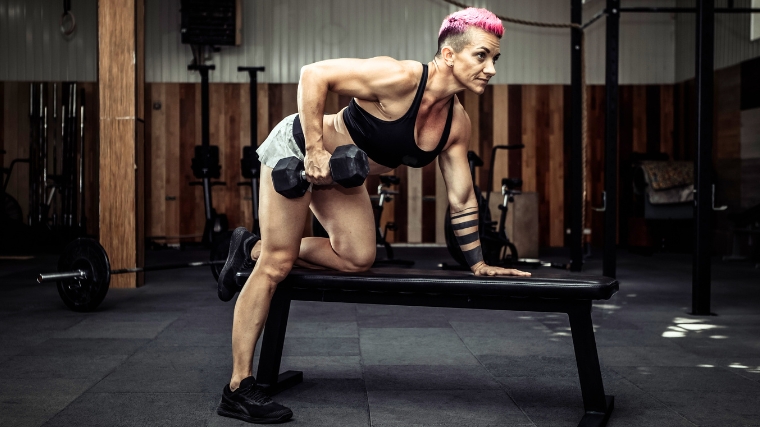
Both approaches rely on periodization. This is particularly true for powerlifters, where hard plateaus and long-term stalling can be devastating to your competitive prospects. Even for powerbuilding goals, a periodized program has been shown to be superior to a non-periodized option in eliciting gains. (1)
Frequency
Frequency is an important consideration for any type of high-intensity training. Barbell exercises can be highly skill-dependent, meaning that getting a great return on your investment (strength, muscle, or some combination) will depend on how well you execute the exercise itself.
For both powerlifting and powerbuilding, you’ll want to select a frequency that allows you to best recover between sessions and accrue meaningful technical practice. Powerlifters often train their competitive lifts anywhere from 2-4 times per week, with different intensity or volume parameters each time. (2)
[Read More: The Best Foods for Energy Before, During, and After Your Workouts]
Powerbuilders can apply this philosophy to their training as well. If you begin your two weekly leg days with the back squat, you’re working with an acceptable frequency for skill development as well. Overall, powerbuilders and powerlifters both hit the gym between 3-6 days per week, albeit with different weekly structures to their workouts.
Exercises and Equipment
As a powerlifter, your workouts mainly consist of barbell exercises to give you the specific strength and coordination adaptations you’re looking for. Your accessory work, though, will involve tools such as bands, cable machines, or even calisthenics training.
While powerbuilding workouts involve barbell training as well, they’ll often abandon free weights a bit earlier into the session in order to keep some quality gas in the tank. To really focus on pushing hard for muscle growth, aim for more stable tools like cables or machines.
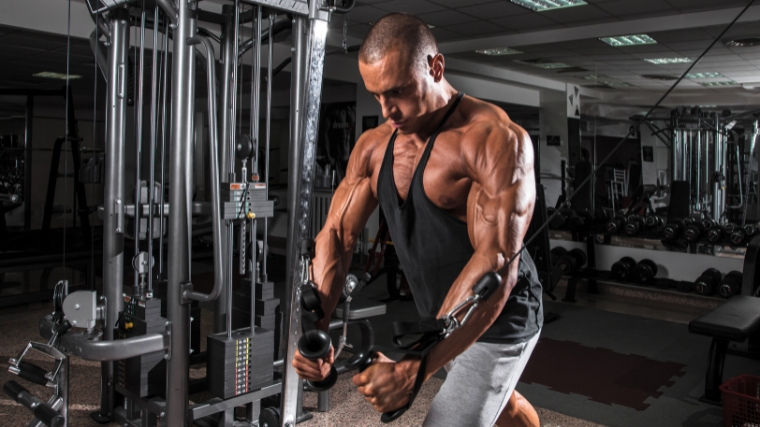
Similarly, powerbuilding utilizes higher-repetition sets earlier in the workout, making it easier to target specific muscle groups in isolation. For example, you may use tools such as dumbbells or machines for sets of 8-15 repetitions as opposed to a powerlifter aiming for 3-6 with free weights.
Powerlifting vs. Powerbuilding Nutrition
Your nutritional habits have a huge impact on your performance regardless of what you’re training for. Both powerlifting and powerbuilding require rapid muscle recovery between workouts to maximize their results. Subtle differences in training goals can impact nutritional considerations.
Powerlifting Nutrition Goals
Powerlifting workouts can be extremely grueling, particularly when you’re “peaking” for a competition or are in the depths of a high-intensity week of workouts. In either case, you should prioritize getting enough protein and total calories to fuel your workouts and ensure you’re recovering appropriately.
[Read More: The Complete Guide to Pre-Workout Supplements]
Although powerlifting is a weight class sport, maintaining a specific body composition isn’t necessarily critical. Strength depends primarily on motor skill competence; how much muscle you carry matters, but you don’t need a specific amount of muscle to succeed in powerlifting. As long as you fit within your desired weight class, you needn’t worry too much about how much muscle or fat you’re carrying (though more lean tissue is, of course, better than less).
Powerbuilding Nutrition Goals
Powerbuilding’s split focus on both strength and aesthetics means that you need to eat to both fuel your workouts and maintain an acceptable body composition. In practical terms, this means eating enough to build muscle and train hard, but not too much that you put on unwanted fat.
[Related: The Definitive Guide to Bodybuilding Meal Prep]
To accomplish this, you will need to once again set calorie and protein targets, but you also will likely need to employ some form of dietary planning and caloric control. Having phases of growth (or bulking) and times to cut (lose body fat) are common in bodybuilding, and carry over effectively to powerbuilding as well.
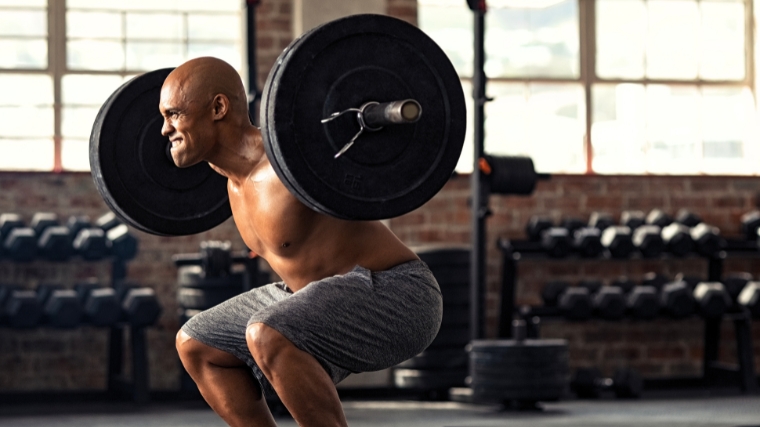
[Related: The Gymgoer’s Guide to Whey Protein]
A bulking phase will push you into a caloric surplus to gain weight. It’s highly recommended that you take a long, slow approach here in order to maximize muscle gain and minimize fat gain along with it. This is particularly important as you gain more experience and your rate of muscle gain slows. (3)
A cutting phase employs a strategic calorie deficit to lose as much body fat as possible and lean out. Similar to a bulk, you should approach this with a long-game mentality. The faster you lose weight — especially as you get leaner — the higher likelihood of muscle loss along with it. (4)
Powerlifting Vs. Powerbuilding Competition
Powerlifting is a training style for some, but in truth is a legitimate strength sport. The path of a competitive powerlifter will ultimately lead towards a competition (or meet, as they’re called): A day where you go head to head with other athletes and test your top squat, bench press, and deadlift performances.
Powerbuilding is more of a training philosophy — it has no specific sport of its own to organize around. However, since it double dips in both powerlifting and bodybuilding methodologies, it can be used as an introduction to more rigid powerlifting or bodybuilding programs.
Powerlifting Competition
Powerlifting competitions will separate you into weight classes to go head-to-head with similarly sized competitors in testing your maximal strength. There are three exercises — the squat, bench press, and deadlift — during which you get three attempts to post your highest score (successfully completed repetition). The athlete with the highest combined total weight lifted between all of their best attempts per exercise will be declared the winner.
[Read More: Build a Titanic Torso with These Bodybuilding Chest & Back Workouts]
Oftentimes a “best lifter” of the entire meet will be declared based upon a calculation made comparing total weight lifted and scaled to bodyweight between competitors.
Powerbuilding Competition Options
There are no powerbuilding competitions. However, those who partake in powerbuilding can usually use their gains in more specific contexts.
You can train as a powerbuilder and build strength in the squat, bench press, and deadlift, albeit likely at a slower pace, while also building substantial muscle. By keeping major strength training at its core, you can simply peak and compete in powerlifting at your leisure.
Powerbuilding can also be a less specific method of building significant muscle in preparation for a bodybuilding show. Similar to peaking for powerlifting, powerbuilding can prepare you during the off season where you will have a much larger amount of calories and recovery to play with. Once you enter a “prep cycle” to diet down for a bodybuilding show, you can shift your training away from compound movements if you wish to spare some energy.
Can You Do Both Powerlifting and Powerbuilding?
In truth, combining powerlifting and powerbuilding amounts to semantics. Powerbuilding is already a mix of training styles, after all.
In real world terms, blending the two would simply take the form of adding more accessory work to a powerlifting routine, or doing more barbell exercises in a powerbuilding workout. That said, there are some key points to consider if you’re thinking of combining the two.
- You will likely need to modify some of the exercise selection and volume to peak for your powerlifting meets.
- You will need to stay on top of your weight class requirements.
- Periodizing your main powerlifting exercises is a must.
- Your powerlifting exercises will likely remain staples within your program.
Sample Workouts
It may help you decide between powerlifting and powerbuilding to see a sample of each workout. Here’s a layout of a chest or “push” workout from both a powerlifter’s and powerbuilder’s perspective.
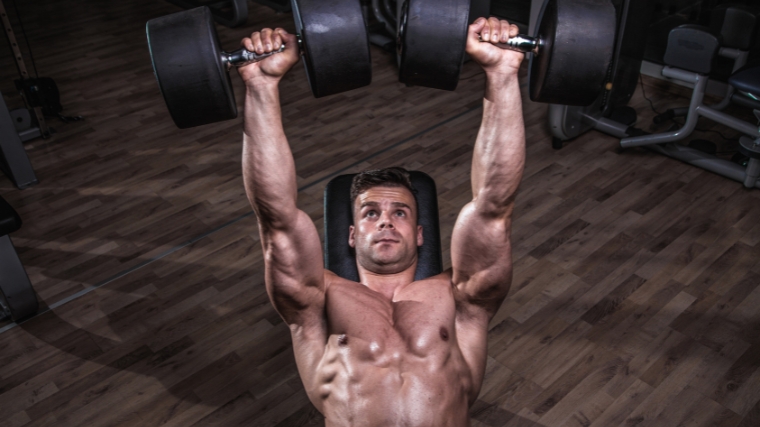
[Read More: The Best Full-Body Bodybuilding Workout for Beginner to Advanced Lifters]
Note that both workouts begin with free-weight barbell exercises. The powerlifter will focus more on accessory work that supplements their performance of the bench press as a skill, while the powerbuilder will continue to hammer their pecs and triceps with other exercises for muscle growth.
Powerlifting
- Bench Press: 3 x 5
- Close-Grip Bench Press: 2 x 5
- Single-Arm Dumbbell Row: 3 x 8
- Pull-Up: 2 x AMRAP
- Single-Arm Overhead Cable Triceps Extension: 2 x 15
Note: AMRAP = as many repetitions as possible.
Powerbuilding
- Bench Press: 3 x 5
- Incline Dumbbell Bench Press: 3 x 10
- Weighted Dip: 2 x AMRAP
- Machine Cable Flye: 3 x 12
- Single-Arm Cable Triceps Pushdown: 2 x 10
- Single-Arm Overhead Cable Triceps Extension: 2 x 15
- Dumbbell Lateral Raise: 3 x 12
The Power Is in Your Hands
Powerlifting and powerbuilding offer you a difficult choice to make. They both will allow you to get stronger, develop your physique, and enjoy some of the finer experiences in the weight room (including but not limited to hitting personal records). The major rub is where you place your highest priorities in training.
Powerbuilding gives you the option to diverge from the narrow pursuit of maximal strength in exchange for some muscle gains on the side. The pace of both will be slowed, but you won’t need to ultimately concede either.
Powerlifting may be a bit more rigid in its requirements, but if you’re chomping at the bit to test your mettle in maximal strength, it’s probably right for you. Weigh your options alongside your goals — whether it’s powerlifting or powerbuilding, the power is in your hands.
References
- Williams, T. D., Tolusso, D. V., Fedewa, M. V., & Esco, M. R. (2017). Comparison of Periodized and Non-Periodized Resistance Training on Maximal Strength: A Meta-Analysis. Sports medicine (Auckland, N.Z.), 47(10), 2083–2100.
- Rhea, M. R., Ball, S. D., Phillips, W. T., & Burkett, L. N. (2002). A comparison of linear and daily undulating periodized programs with equated volume and intensity for strength. Journal of strength and conditioning research, 16(2), 250–255.
- Iraki, J., Fitschen, P., Espinar, S., & Helms, E. (2019). Nutrition Recommendations for Bodybuilders in the Off-Season: A Narrative Review. Sports (Basel, Switzerland), 7(7), 154.
- Aragon, A. A., Schoenfeld, B. J., Wildman, R., Kleiner, S., VanDusseldorp, T., Taylor, L., Earnest, C. P., Arciero, P. J., Wilborn, C., Kalman, D. S., Stout, J. R., Willoughby, D. S., Campbell, B., Arent, S. M., Bannock, L., Smith-Ryan, A. E., & Antonio, J. (2017). International society of sports nutrition position stand: diets and body composition. Journal of the International Society of Sports Nutrition, 14, 16.
Feature Image: Bojan656 / Shutterstock